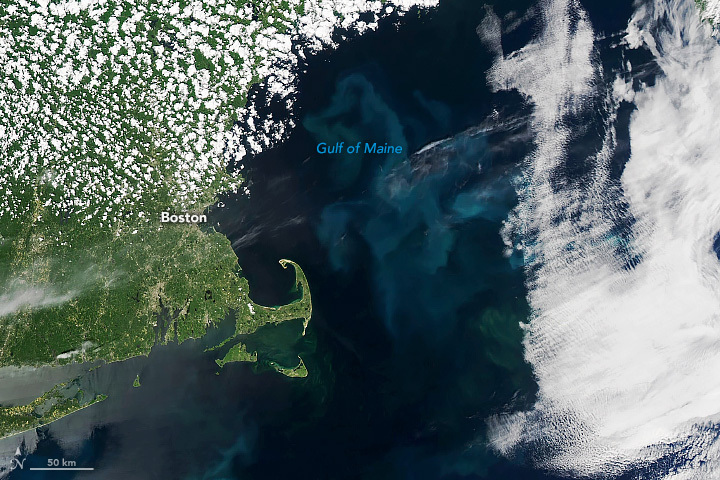Over the past two decades, productivity in the fishery-heavy waters has dropped 65%
7 June 2022
AGU press contact:
Rebecca Dzombak, +1 (202) 777-7492, [email protected] (UTC-4 hours)
Bigelow Laboratory press contact:
Fritz Freudenberger, [email protected] (UTC-4 hours)
NASA press contact:
Ellen Gray, NASA Goddard Space Flight Center, [email protected] (UTC-4 hours)
Contact information for the researchers:
William Balch, Bigelow Laboratory, [email protected] (UTC-4 hours)
The Gulf of Maine has lost up to 65% of its productivity from phytoplankton over two decades, destabilizing the base of the region’s food web, according to a new study. The Gulf is getting warmer and saltier due to ocean currents pushing warm water into the gulf from the Northwest Atlantic, prompting the loss, the Journal of Geophysical Research Biogeosciences study found.
The Gulf of Maine, which stretches from Cape Cod in Massachusetts to the southern tip of Nova Scotia, helps fuel New England’s marine ecosystems and economy. Like plants on land, phytoplankton absorb carbon dioxide from the atmosphere and use photosynthesis to grow, and then become a food source for other organisms. Disruptions to their productivity can lead to adverse effects on the region’s fisheries and the communities that depend on them.
“Phytoplankton are at the base of the marine food web on which all of life in the ocean depends, so it’s incredibly significant that its productivity has decreased,” said William Balch, a biological oceanographer at Bigelow Laboratory who led the study. “A drop of 65 percent will undoubtedly have an effect on the carbon flowing through the marine food web, through phytoplankton-eating zooplankton and up to fish and apex predators.”
The results come from the research team’s analysis of the Gulf of Maine North Atlantic Time Series (GNATS), a 23-year sampling program of the temperature, salinity, chemical, biological, and optical measurements of the gulf. These measurements are critical to make sure satellite observations from space are accurate. Balch said the changes that they are recording show an intricate connection between the gulf and the greater Atlantic Ocean.
“It’s all being driven by this gigantic windmill effect happening out in the North Atlantic, which is also changing the circulation coming into the Gulf of Maine,” Balch explained. “There used to be these inflows from the North Atlantic bringing water from the southward-flowing Labrador Current, making the gulf cooler and fresher, as opposed to warmer and saltier, which is where we are now.”
Since 1998, the Bigelow Laboratory has tracked several biogeochemical changes in the gulf with GNATS. The team collects samples via commercial ferries and research vessels running the same routes repeatedly. They also use autonomous gliders that cross the same sampling line.
The GNATS dataset ultimately will compare changes observed directly on the gulf’s surface waters to observations by NASA satellites acquiring ocean color data. The measurements complement satellite observations from space that can sometimes be clouded by fog.
Data on the many colors of the ocean associated with different types of concentrations of phytoplankton within the GNATS dataset are expected to contribute to the upcoming observations by NASA’s Plankton, Aerosol, Cloud, ocean Ecosystem mission, which will help study phytoplankton communities and track harmful algal blooms that can disrupt ecosystems, fisheries and tourism in the Gulf of Maine.
“We are focused very much on that lower level, the phytoplankton level,” said Catherine Mitchell, an oceanographer at Bigelow Laboratory and a study coauthor. “But the changes at that level can have all these implications at the higher species, the fisheries, the lobster, and all those kinds of industries that are important within the state of Maine and other states that border the gulf.”
###
AGU (www.agu.org) supports 130,000 enthusiasts to experts worldwide in Earth and space sciences. Through broad and inclusive partnerships, we advance discovery and solution science that accelerate knowledge and create solutions that are ethical, unbiased and respectful of communities and their values. Our programs include serving as a scholarly publisher, convening virtual and in-person events and providing career support. We live our values in everything we do, such as our net zero energy renovated building in Washington, D.C. and our Ethics and Equity Center, which fosters a diverse and inclusive geoscience community to ensure responsible conduct.
Notes for Journalists:
This research study is published with open access and is freely available. Download a PDF copy of the paper here. Neither the paper nor this press release is under embargo.
Paper title:
“Changing hydrographic, biogeochemical and acidification properties in the Gulf of Maine as measured by the Gulf of Maine North Atlantic Time Series, GNATS, between 1998-2018”
Author information:
- William M. Balch (corresponding author), David T. Drapeau, Bruce C. Bowler, Nicholas R. Record, Sunny Pinkham, Catherine Mitchell, Bigelow Laboratory for Ocean Sciences, East Boothbay, ME
- Nicholas R. Bates, Rabecca Garley, Bermuda Inst. Of Ocean Sciences, St. George, Bermuda
Released jointly with Bigelow Laboratory and NASA Goddard
